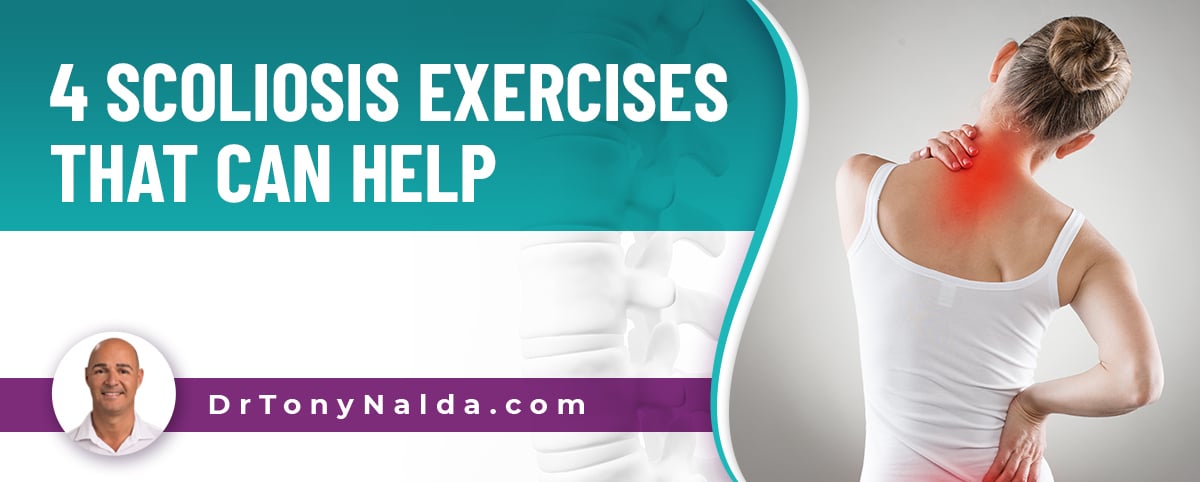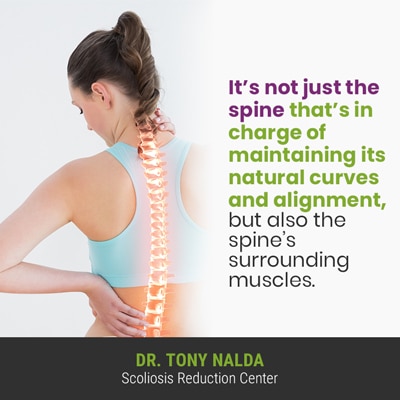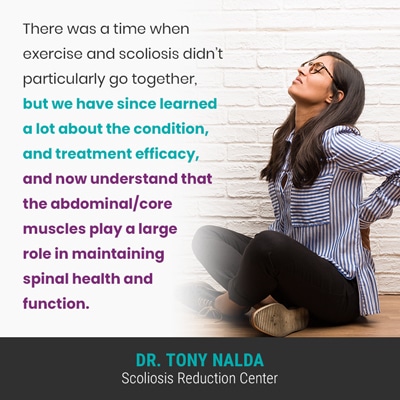4 Scoliosis Exercises That Can Help

While no type of exercise can change the structure of a scoliotic spine, condition-specific exercises for scoliosis can help increase core strength, keep the spine as flexible as possible, and reduce pain related to weak, sore, and imbalanced muscles surrounding the unnatural spinal curve.
Exercise wasn't always used in scoliosis treatment, but our understanding of the condition has evolved over the years to include the connection between core strength and spinal support. Certain exercises can also help address pain caused by spinal rigidity, strained, and/or imbalanced muscles.
Let's first address how scoliosis affects the body in general, before focusing on the specifics of scoliosis exercises and what they can help with.
Table of Contents
The Scoliotic Spine
In a healthy spine, its natural curves help it to absorb and distribute mechanical stress during activity, and give it extra flexibility and strength, like a coiled spring.
In a spine with its healthy curves in place, the bones of the spine (vertebrae) remain stacked on top of one another in a straight line and neutral position, but if one or more of the spine's healthy curves is lost, it's replaced by an unhealthy curve, and this means the vertebrae are no longer aligned as they should be.
A spine that's out of alignment is a spine that's not going to function as well, and over time, it can lead to increased rates of spinal degeneration, and a number of other issues.
A scoliotic spine has an unnatural lateral (sideways) spinal curvature and doesn't just bend unnaturally, but also twists; it's the rotational component that makes scoliosis a 3-dimensional condition.
Scoliosis is Progressive and Structural
In addition, scoliosis is progressive, meaning its nature is to worsen over time, and this means the unnatural spinal curve is virtually guaranteed to increase in size.
Scoliosis is also a structural condition, meaning it involves a structural abnormality within the spine itself (the unnaturally-tilted vertebrae and rotation of the spine), and because it's structural, the scoliotic curve can't be reduced/corrected with a change in position, or by making an active effort to practice good posture.
With that in mind, exercises for scoliosis also can't actually reduce/correct a scoliotic curve, but they can help facilitate treatment success in other ways.
How Can Scoliosis Exercises Help?
As mentioned, scoliosis is a structural condition, and this means that in order to reach treatment success, the condition has to be impacted, first and foremost, on a structural level because the underlying nature of scoliosis is structural.
While no exercise on its own can induce a structural change, scoliosis-specific exercises and physical therapy can help augment corrective results in the following ways:
Core Strengthening
 It's not just the spine that's in charge of maintaining its natural curves and alignment, but also the spine's surrounding muscles.
It's not just the spine that's in charge of maintaining its natural curves and alignment, but also the spine's surrounding muscles.
As scoliosis introduces a lot of uneven forces to the body, the muscles that surround the spine can become strained and exposed to uneven wear as they struggle to support and stabilize the unnatural spinal curve.
In addition, as scoliosis is progressive, the abdominal muscles are constantly working to try and counteract the uneven forces of the condition, especially as progression occurs.
Strengthening the core muscles and keeping the abs tight is an important part of treatment because even if a patient has achieved a significant reduction through chiropractic treatment, that reduction has to be held where it is, and spinal support is a key element of the ability to sustain structural treatment results.
Addressing Sore, Tight, Strained and Imbalanced Muscles
As mentioned, the condition's uneven forces can disrupt the body's overall symmetry, and this presents as postural deviation: uneven shoulders, shoulder blades, hips, the development of a rib cage arch, and arms and legs that appear to hang at different lengths.
These types of postural changes also affect the muscles in the area, and even though scoliosis isn't compressive until adulthood, which is why children don't commonly experience a lot of back pain/radicular pain, they do commonly experience varying levels of muscle pain; this is due to strained, sore, stiff, and unbalanced muscles.
A physical therapist can use the power of scoliosis exercises for core strengthening so the spine can receive optimal support and can also work towards strengthening muscles that have become weak, building them up so they are balanced on both sides of the spine, and also keeping them as strong and loose as possible, to address muscle pain.
In addition, a corrective exercise specialist, with a focus on scoliosis, understands the ability of certain scoliosis-specific exercises (SSEs) to stimulate brain-body communication to facilitate correct posture and a more natural body positioning.
In another obvious way, exercises can help people with scoliosis by helping them maintain a healthy body weight; carrying excess weight puts more pressure on the spine, its individual structures and joints.
So now that we've addressed some of the general benefits of scoliosis-specific exercises, let's talk about some specific exercises that can be helpful.
Exercises to Help with Scoliosis
 There was a time when exercise and scoliosis didn't particularly go together, but we have since learned a lot about the condition, and treatment efficacy, and now understand that the abdominal/core muscles play a large role in maintaining spinal health and function.
There was a time when exercise and scoliosis didn't particularly go together, but we have since learned a lot about the condition, and treatment efficacy, and now understand that the abdominal/core muscles play a large role in maintaining spinal health and function.
Here at the Scoliosis Reduction Center, I apply a conservative chiropractic-centered treatment approach to help patients work towards a structural curvature reduction, and once I see those kinds of structural results, I shift the focus to increasing strength of the core muscles.
Now, there are a variety of physical therapies that rely on the power of condition-specific exercise such as schroth exercises used in the schroth method and SEAS (scientific exercise approach to scoliosis), which I'm certified in.
These physical therapy approaches develop programs that facilitate core strengthening, spinal mobility, postural remodeling, and healthy breathing which can make the spine more responsive to treatment, particularly manual chiropractic adjustments.
While no form of exercise should be added to a scoliosis patient's exercise regime without first clearing it with the treatment provider, if approved, the following exercises can help improve the position of the spine by increasing core and lower-back strength:
Pelvic Tilt
Performing pelvic tilts can help scoliosis by stretching tight hip and lower-back muscles, which is ideal for people with lumbar scoliosis.
Performing the pelvic tilt is simple, safe, can be done without the help of a personal trainer, and can be highly effective.
To perform the pelvic tilt properly:
- Lie down on the floor with the feet flat to the floor and the knees bent
- While engaging the core (tighten the stomach muscles), try and flatten the back by gently pushing it into the floor below
- Take a deep breath to help regulate breathing, and hold the pose for 5 seconds
- After releasing the pose, repeat it for 2 sets of 10
Latissimus Dorsi Stretch
Performing a latissimus stretch can be particularly helpful with scoliosis in the thoracic spine (middle/upper back) because it's the upper body's largest muscle.
People with lumbar scoliosis can also benefit from this stretch as adverse spinal tension can travel upwards, above the unnatural spinal curve's location, to affect the latissimus dorsi muscles above.
To perform the latissimus stretch:
- Stand up straight with the spine in an aligned and neutral position
- While standing with feet shoulder width apart, bend the knees slightly
- Slowly raise both arms up over the head, toward the ceiling, and hold the right wrist with the left hand
- Bend gently to the right until the stretch is felt in the left side
- Hold the pose for 5 seconds and repeat on the opposite side, with the opposite arm, feeling the stretch on the right side
- Performing 5 to 10 repetitions on each side can stretch the latissimus dorsi muscles effectively
Abdominal Press
Exercises for scoliosis that strengthen the core muscles can help take pressure off the back muscles, facilitating their support of the spine, and a strong core also helps with good posture and keeping the spine in a healthy position.
To perform an abdominal press:
- Lie down flat on the floor with the knees bent
- Raise the lower legs above the floor at a 90-degree angle (resting them on a chair is okay)
- Use the hands to put pressure on the knees while pulling the hands and knees together at the same time (creating resistance)
- Try to keep the arms and legs still while applying pressure
- Hold the pose for 7 seconds and perform 2 sets of 10
Hip Flexor Stretch
Stretching can also be helpful for people with scoliosis; they can help keep the spine and its surrounding muscles as flexible and loose as possible.
As uneven hips are one of the postural changes associated with scoliosis, this means one hip is sitting higher than the other, which means one side is carrying more weight than the other, and this can cause uneven wear, degeneration, and pain.
The hip flexor muscle group keeps the hips and lower back flexible and aligned, and stretching this muscle group with proper technique involves:
- For those feeling tight on the right side, kneel down on the right leg, while bending the left leg straight in front and keeping the left foot flat on the floor.
- For tightness on the left side, work the opposite side.
- While being mindful of keeping the spine in a straight line, slowly bring the hips forward until there is a stretch felt in the right leg's upper thigh and hip.
- Hold each post for 15 to 30 seconds
As stiffness and rigidity increases with progression, performing certain stretches in a symmetrical manner can help loosen the spine, the hips, and surrounding muscles.
Conclusion
Part of treating scoliosis effectively involves the prescription of certain scoliosis-friendly exercises and stretches.
While no exercise on its own can reduce/correct an unnatural spinal curve, the right types of exercises and physical therapy can help facilitate treatment efficacy by keeping the abdominal muscles strong so they can better support the spine.
In addition, keeping the spine loose and flexible means a spine that's going to be more responsive to treatment, particularly chiropractic care.
The aforementioned exercises can be easily done at home with little more than an exercise mat and a chair.
When performed as prescribed, and designed by a scoliosis specialist, exercises can also help by reducing pain, meaning patients are better able to handle the challenges of treatment for different severity levels and types: severe scoliosis, moderate scoliosis, mild scoliosis, and idiopathic scoliosis.
Here at the Center, through an integrative approach, condition-specific exercises can help augment corrective results achieved through other treatment disciplines, and can help further stabilize/rehabilitate the spine by establishing a home exercise program.
Dr. Tony Nalda
DOCTOR OF CHIROPRACTIC
After receiving an undergraduate degree in psychology and his Doctorate of Chiropractic from Life University, Dr. Nalda settled in Celebration, Florida and proceeded to build one of Central Florida’s most successful chiropractic clinics.
His experience with patients suffering from scoliosis, and the confusion and frustration they faced, led him to seek a specialty in scoliosis care. In 2006 he completed his Intensive Care Certification from CLEAR Institute, a leading scoliosis educational and certification center.
About Dr. Tony Nalda
 Ready to explore scoliosis treatment? Contact Us Now
Ready to explore scoliosis treatment? Contact Us Now





